At the time of writing, the ECB has cut the refi rate to 1% and signalled that it
offers three-year fixed rate repos with full allotment at the ongoing refi rate at the same time as collateral criteria are eased. In other words, it is doing its utmost to support the banking system for which it is “lender of last resort”. At the same time it seems clear that it does not want to be the lender of last resort for governments – i.e. it does not pull out the “bazooka”, which would be to overrule its regulations and it even seems doubtful whether it would try to circumvent it via loans to the IMF. We cannot completely rule out this possibility, even though it seems very unlikely. Market reaction has swung from positive to slightly negative, probably due to lack of “bazookas”.
Await the EU summit - keep an eye on inflation/unemployment
We prefer to await the outcome of the EU summit proposing changes to the EU Treaty before giving advice on FI strategies for the near-term. Hopefully, we will have some more specific knowledge of what kind of change leaders want to achieve, which countries that are willing to do that and what the timeframe looks like. Then we would also know whether this is something that appeals to the market, or if it is a paper tiger that we have seen so many times before.
Nonetheless, there is much important domestic data due in the coming week worth considering, such as November inflation and unemployment. Both have – as we are all aware – a bearing on Riksbank’s forecast for the repo rate path.
Remember that the October inflation outcome was surprisingly low. As it turned out, 11 of 15 components that we forecast were lower than expected, suggesting that inflationary pressures are fading quickly.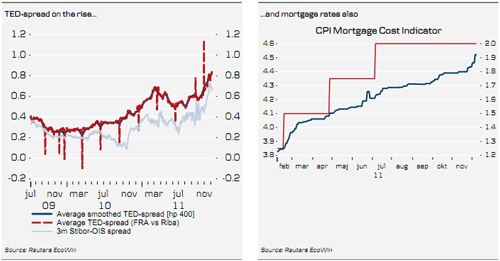
Clothing was on sale as early as November, which means there is a downside risk to our forecast. This is probably also the case for our calls on car and furniture prices. On the other hand, we may have been too soft on recreation, restaurant and hotel prices – suggesting some upside risk. All in all, downside risks should dominate against the background of growing recession risk and the ongoing debt crisis in the eurozone. This does not exactly favour consumers being very prone to consume. On the energy side, petrol prices probably dropped by a percentage point or so, while there was a substantial rise in electricity costs, of about 4%. However, electricity futures for Q1 12 on Nordpool
trade roughly 50% below last year, which bodes well for stable to falling prices in the month(s) to come. Finally, mortgage rates remained largely unchanged in November, but appear to have risen strongly in December – up some 4%. The reason is that bank’s funding costs have soared as the monetary transmission mechanism is about to be dissolved. This is illustrated by TED-spread (the difference between FRA and Riba), which has widened sharply and hence leads to rising rates for consumers and businesses, despite the repo rate being unchanged. We expect the Riksbank would have to correct this, using longer-term fixed repos, if ordinary rate cuts do not lead to lower rates for banks’ clients. In the following, we show our inflation forecasts relative to Riksbank’s – there is a huge difference! 
Unemployment rate developments are a key for the economy. Unemployment is decisive for the government budget balance as both VAT and income taxes fall at the same time as unemployment benefit expenditures rise and unemployment rises. A crude rule of thumb is that every percentage point rise in the unemployment rate is “worth” about SEK100bn – at least that appears to have been the case over the past couple of years. Moreover, a deteriorating labour market may be particularly important now, as the property market is cooling too. Rising unemployment may pull down house prices more than is desirable.
Finally, the unemployment rate is an important indicator – maybe the most important – for resource utilisation and, in extension, for inflationary pressures. In the following charts there are several employment indicators that can be seen as early signals for the unemployment rate. 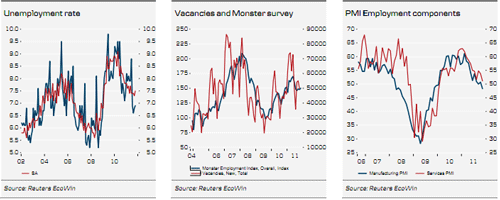
No stress - just tighter monetary policy
In the previous edition of Reading the Markets – Sweden we discussed wider fixing spreads and the liquidity measures planned by the ECB. The first US dollar facility after the improved terms was executed yesterday and attracted more interest compared with previous facilities. However, so far the effect on EURIBOR rates and, above all, the creation of Swedish krona from EURIBORs has been very limited. In fact, creating krona from EURIBORS and US LIBOR (with 50:50 weighting) implies a more or less unchanged “cost”. Thus, despite more liquidity in Europe it has failed to ease funding costs for Swedish banks. It is clear that in order to lower funding costs the Riksbank has to introduce liquidity facilities. But why should the Riksbank launch such a measure that would reduce domestic banks funding costs? The question is rather if the Riksbank is honest about its monetary policy stance.
Since the last rate hike in July 3M mortgage rates have continued to move higher. All together, the 3M mortgage lending rates are up some 70bp compared with early-July. Hence, rising costs, equal to almost three repo rate hikes, have hit many households during the autumn. Does this matter? For the time being, some 50% of households have their mortgage costs linked to flexible rate (3M). The share of lending to flexible rate terms peaked in summer-2010 at 60%. Moreover, we assume that companies that are exposed to, more or less, flexible borrowing terms also have experienced higher costs. So, for a big chunk of the economy the costs for borrowing has increased quite significantly during the autumn. Monetary policy has tightened over the past five months almost by as much as equal to three repo rate hikes. We do believe this matters (see retail sales and lending to both households and companies if in doubt), but is the Riksbank aware of the fact that its monetary policy stance over the past five months (i.e. unchanged) has not worked? 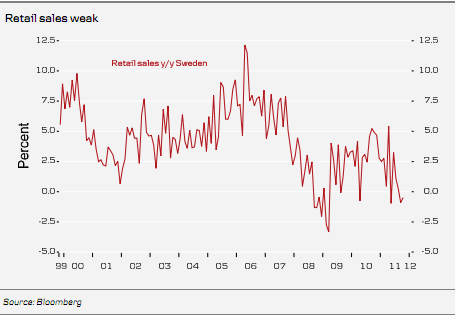
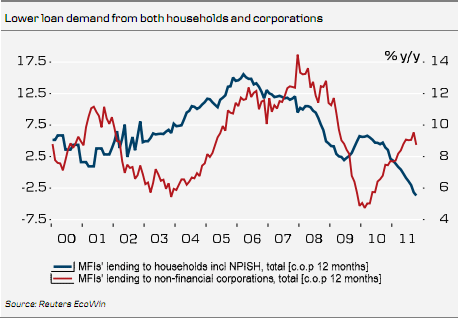
The transmission mechanism, which when it works should transfer the Riksbank’s monetary policy into the real economy, has broken down. Should the Riksbank bother? We read the monetary policy discussion in the minutes about what the rate path should imply in terms of end repo rate in 2014. We argue that it is much more important and relevant to discuss how the monetary policy is affecting the economy right now. Why bother about the policy rate in 2014 when the effective rate has increased by 75bp since the summer, when it was meant to be unchanged? 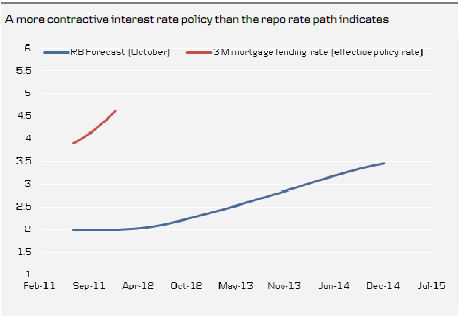
It is true that the Swedish money market isn’t in stress. Swedish banks do have access to funding in Swedish krona, euros and US dollars – but at a very elevated price that is still increasing. So financial stability is not an issue in that perspective, but as Svensson argues in the most recent minutes: “The policy for financial stability has its own objective… The policy for financial stability affects financial markets, spreads between interest rates, the functioning of financial markets and the transmission mechanism. This means that monetary policy must give consideration to how the policy for financial stability is conducted when setting the interest rate to attain the monetary policy objectives”. We believe this support our notion that the Riksbank lacks one important part in its current analysis and need to take the transmission mechanism into closer consideration going forward.
So, we ask ourselves: when will the Riksbank wake up and realise that its current combined policy for monetary and financial stability is, actually, resulting in tighter “monetary policy”. There is no stress in the financial markets, but the transmission mechanism is broken and needs to be mended if the Riksbank is honest about its monetary policy.
FRA rates are up substantially together with shorter mortgage bonds. We still have faith in our key trade for 2012, which is steeper curves and outperformance of shorter mortgage bonds. We like to combine this in one trade, buying two-year mortgage bonds and selling the 10-year government bond. The Swedish economy will inevitably be hit when the most important export market (western Europe) is engaged in heavy austerity measures (in fact independently of how the current debt crisis unfolds). Policy rates will have to be reduced significantly and be kept there for a long time. We doubt 10-year rates will go much lower unless the situation deteriorates further. That would probably mean a chaotic situation in European financial markets and in such an environment we believe policy rates have been quickly slashed to close to zero and that central banks have pumped liquidity into the market – resulting in a steeper curve. 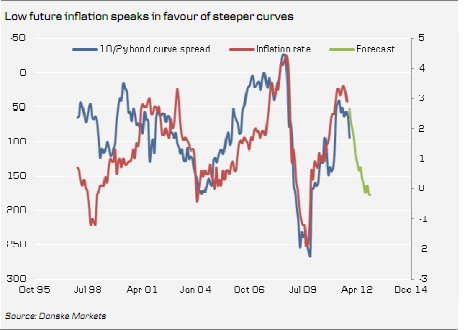
In order to maintain our long-term strategy for a steeper curve in 2012 we have decided to hedge the short leg (long position in mortgage bonds) by going for a wider TED-spread in the FRAJUN12 vs RIBASEP12, currently at 73bp. Hence, we establish a protection to further fixing woes, but keep our long-term call. Moreover, when the curve position with a long mortgage bond position at the front is hedged we can alter our profit/loss target. The stop level is cut and the profit level raised in order to reflect the long-term nature of the strategy.
We close our recommendation to go outright long in short-dated mortgage bonds (with a small profit) and our recommendation to go for a flatter swap curve relative to the FRA curve, since it has reached our loss level. The latter has been negatively affected by wider fixing spreads.
- English (UK)
- English (India)
- English (Canada)
- English (Australia)
- English (South Africa)
- English (Philippines)
- English (Nigeria)
- Deutsch
- Español (España)
- Español (México)
- Français
- Italiano
- Nederlands
- Português (Portugal)
- Polski
- Português (Brasil)
- Русский
- Türkçe
- العربية
- Ελληνικά
- Svenska
- Suomi
- עברית
- 日本語
- 한국어
- 简体中文
- 繁體中文
- Bahasa Indonesia
- Bahasa Melayu
- ไทย
- Tiếng Việt
- हिंदी
The ECB Does What It Can - But No “Bazooka”
Published 12/12/2011, 07:59 AM
The ECB Does What It Can - But No “Bazooka”
The ECB does what it can - but no "bazooka"
Latest comments
Loading next article…
Install Our App
Risk Disclosure: Trading in financial instruments and/or cryptocurrencies involves high risks including the risk of losing some, or all, of your investment amount, and may not be suitable for all investors. Prices of cryptocurrencies are extremely volatile and may be affected by external factors such as financial, regulatory or political events. Trading on margin increases the financial risks.
Before deciding to trade in financial instrument or cryptocurrencies you should be fully informed of the risks and costs associated with trading the financial markets, carefully consider your investment objectives, level of experience, and risk appetite, and seek professional advice where needed.
Fusion Media would like to remind you that the data contained in this website is not necessarily real-time nor accurate. The data and prices on the website are not necessarily provided by any market or exchange, but may be provided by market makers, and so prices may not be accurate and may differ from the actual price at any given market, meaning prices are indicative and not appropriate for trading purposes. Fusion Media and any provider of the data contained in this website will not accept liability for any loss or damage as a result of your trading, or your reliance on the information contained within this website.
It is prohibited to use, store, reproduce, display, modify, transmit or distribute the data contained in this website without the explicit prior written permission of Fusion Media and/or the data provider. All intellectual property rights are reserved by the providers and/or the exchange providing the data contained in this website.
Fusion Media may be compensated by the advertisers that appear on the website, based on your interaction with the advertisements or advertisers.
Before deciding to trade in financial instrument or cryptocurrencies you should be fully informed of the risks and costs associated with trading the financial markets, carefully consider your investment objectives, level of experience, and risk appetite, and seek professional advice where needed.
Fusion Media would like to remind you that the data contained in this website is not necessarily real-time nor accurate. The data and prices on the website are not necessarily provided by any market or exchange, but may be provided by market makers, and so prices may not be accurate and may differ from the actual price at any given market, meaning prices are indicative and not appropriate for trading purposes. Fusion Media and any provider of the data contained in this website will not accept liability for any loss or damage as a result of your trading, or your reliance on the information contained within this website.
It is prohibited to use, store, reproduce, display, modify, transmit or distribute the data contained in this website without the explicit prior written permission of Fusion Media and/or the data provider. All intellectual property rights are reserved by the providers and/or the exchange providing the data contained in this website.
Fusion Media may be compensated by the advertisers that appear on the website, based on your interaction with the advertisements or advertisers.
© 2007-2025 - Fusion Media Limited. All Rights Reserved.
